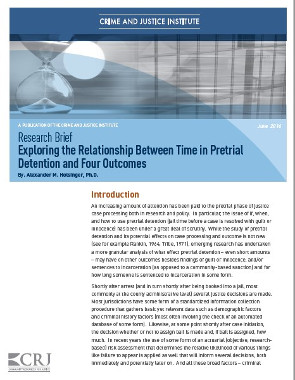
An increasing amount of attention has been paid to the pretrial phase of justice, specifically questions of if, when, and how to use pretrial detention as well as what the potential impact of pretrial incarceration is on defendants.
June 2016
This report tests the relationship between pretrial detention and outcomes during the pretrial period including failure to appear and new criminal activity as well as outcomes post-disposition including 12-month post-disposition arrest, and 24-month post-disposition arrest.
Using data from all defendants arrested and booked into a county jail during calendar years 2011 and 2012, the authors examined the relationship between pretrial stay, duration of pretrial incarceration, and pretrial and post-disposition outcomes.
Overall, findings were mixed. Analysis indicates that as days spent in pretrial increase, the likelihood of failure to appear also increases. However, days spent in pretrial did not have a similar impact on new criminal activity. Regarding post-disposition outcomes, the likelihood of new criminal activity at the 12-month mark was impacted but the same effect was not evident on the 24-month outcomes. Limitations and implications are also discussed.
Click here to read the report.
This project was supported by grant NO. 2010-RR-BX-K073 awarded by the Bureau of Justice Assistance. The Bureau of Justice Assistance is a component of the Office of Justice Programs, which also includes the Bureau of Justice Statistics, the National Institute of Justice, the Office of Juvenile Justice and Delinquency Prevention, the SMART Office, and the Office for Victims of Crime. Points of view or opinions in this document are those of the author and do not represent the official position or policies of the United States Department of Justice.